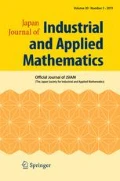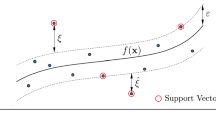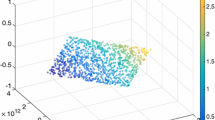Abstract
For numerical simulation of elastic structures, data-driven computational approaches attempt to use a data set of material responses, without resorting to conventional modeling of the material constitutive equation. In a material data set in the stress–strain space, the data points are considered to lie on or near a low-dimensional manifold, rather distribute ubiquitously in the space. This paper presents a kernel method for extracting this manifold. We formulate a regularized least-squares problem for learning a manifold, and show that its optimal solution corresponds to an eigenvector of a real symmetric matrix. Therefore, the method requires only simple computational task, and is easy to implement. We also give a description how to use the obtained solution in static equilibrium analysis of an elastic structure. Numerical experiments on two-dimensional continua are performed to demonstrate effectiveness and robustness of the proposed method.






















Similar content being viewed by others
Notes
Main source codes, as well as data sets, used in this section are available online at https://github.com/ykanno22/data_driven_kernel_manifold/.
Therefore, the assertion “[i]n the linear elastic behavior the application of the just described technique results, as expected, in a flat manifold of dimension two” made in [23, section 2] is questionable.
From a practical point of view, it seems to be unrealistic to suppose that millions data points of material experiments are available for a single material.
The value of k for kNN was determined based on preliminary numerical experiments.
In this example, any value of \(\varepsilon ^{(l+1)}\) satisfies the compatibility relation.
This seems to be natural, because the reference solution assumes that all the Gauss evaluation points have the common Young’s modulus and Poisson’s ratio, while Young’s modulus and Poisson’s ratio of the data points used in the proposed method are different from each other.
This large variance of the method using the local regression may possibly be mitigated if we use the local robust regression like Kanno [26].
References
Ayensa-Jiménez, J., Doweidar, M.H., Sanz-Herrera, J.A., Doblaré, M.: A new reliability-based data-driven approach for noisy experimental data with physical constraints. Comput. Methods. Appl. Mech. Eng. 328, 752–774 (2018)
Banimahd, M., Yasrobi, S.S., Woodward, P.K.: Artificial neural network for stress-strain behavior of sandy soils: knowledge based verification. Comput. Geotech. 32, 377–386 (2005)
Belkin, M., Niyogi, P.: Laplacian eigenmaps for dimensionality reduction and data representation. Neural Comput. 15, 1373–1396 (2003)
Bessa, M.A., Bostanabad, R., Liu, Z., Hu, A., Apley, D.W., Brinson, C., Chen, W., Liu, W.K.: A framework for data-driven analysis of materials under uncertainty: countering the curse of dimensionality. Comput. Methods Appl. Mech. Eng. 320, 633–667 (2017)
Bishop, C.M.: Pattern Recognition and Machine Learning. Springer, New York (2006)
Bock, F.E., Aydin, R.C., Cyron, C.J., Huber, N., Kalidindi, S.R., Klusemann, B.: A review of the application of machine learning and data mining approaches in continuum materials mechanics. Front. Mater. 6, 110 (2019)
Clément, A., Soize, C., Yvonnet, J.: Computational nonlinear stochastic homogenization using a nonconcurrent multiscale approach for hyperelastic heterogeneous microstructures analysis. Int. J. Numer. Methods Eng. 91, 799–824 (2012)
Conti, S., Müller, S., Ortiz, M.: Data-driven problems in elasticity. Arch. Ration. Mech. Anal. 229, 79–123 (2018)
Crespo, J., Latorre, M., Montáns, F.J.: WYPIWYG hyperelasticity for isotropic, compressible materials. Comput. Mech. 59, 73–92 (2017)
Crespo, J., Montáns, F.J.: Function-refresh algorithms for determining the stored energy density of nonlinear elastic orthotropic materials directly from experimental data. Int. J. Non-Linear Mech. 107, 16–33 (2018)
Dalémat, M., Coret, M., Leygue, A., Verron, E.: Measuring stress field without constitutive equation. Mech. Mater. 136, 103087 (2019)
De Rosa, E., Latorre, M., Montáns, F.J.: Capturing anisotropic constitutive models with WYPiWYG hyperelasticity; and on consistency with the infinitesimal theory at all deformation levels. Int. J. Non-Linear Mech. 96, 75–92 (2017)
Donoho, D.L., Grimes, C.: Hessian eigenmaps: locally linear embedding techniques for high-dimensional data. Proc. Natl. Acad. Sci. USA 100, 5591–5596 (2003)
Eggersmann, R., Kirchdoerfer, T., Reese, S., Stainier, L., Ortiz, M.: Model-free data-driven inelasticity. Comput. Methods Appl. Mech. Eng. 350, 81–99 (2019)
Ghaboussi, J., Sidarta, D.E.: New nested adaptive neural networks (NANN) for constitutive modeling. Comput. Geotech. 22, 29–52 (1998)
Ghnatios, C., Alfaro, I., González, D., Chinesta, F., Cueto, E.: Data-driven GENERIC modeling of poroviscoelastic materials. Entropy 21, 1165 (2019)
González, D., Chinesta, F., Cueto, E.: Thermodynamically consistent data-driven computational mechanics. Contin. Mech. Thermodyn. 31, 239–253 (2019)
González, D., Chinesta, F., Cueto, E.: Learning corrections for hyperelastic models from data. Front. Mater. 6, 14 (2019)
Hashash, Y.M.A., Jung, S., Ghaboussi, J.: Numerical implementation of a neural network based material model in finite element analysis. Int. J. Numer. Methods Eng. 59, 989–1005 (2004)
He, Q., Chen, J.-S.: A physics-constrained data-driven approach based on locally convex reconstruction for noisy database. Comput. Methods Appl. Mech. Eng. 363, 112791 (2020)
Hastie, T., Tibshirani, R., Friedman, J.: The Elements of Statistical Learning: Data Mining, Inference, and Prediction, 2nd edn. Springer, New York (2009)
Horn, R.A., Johnson, C.R.: Matrix Analysis, 2nd edn. Cambridge University Press, Cambridge (2013)
Ibañez, R., Abisset-Chavanne, E., Aguado, J.V., Gonzalez, D., Cueto, E., Chinesta, F.: A manifold learning approach to data-driven computational elasticity and inelasticity. Arch. Comput. Methods Eng. 25, 47–57 (2018)
Ibáñez, R., Abisset-Chavanne, E., González, D., Duval, J.-L., Cueto, E., Chinesta, F.: Hybrid constitutive modeling: data-driven learning of corrections to plasticity models. Int. J. Mater. Form. 12, 717–725 (2019)
Ibañez, R., Borzacchiello, D., Aguado, J.V., Abisset-Chavanne, E., Cueto, E., Ladeveze, P., Chinesta, F.: Data-driven non-linear elasticity: constitutive manifold construction and problem discretization. Comput. Mech. 60, 813–826 (2017)
Kanno, Y.: Simple heuristic for data-driven computational elasticity with material data involving noise and outliers: a local robust regression approach. Jpn. J. Ind. Appl. Math. 35, 1085–1101 (2018)
Kanno, Y.: Mixed-integer programming formulation of a data-driven solver in computational elasticity. Optim. Lett. 13, 1505–1514 (2019)
Kanno, Y.: Dimensionality reduction enhances data-driven reliability-based design optimizer. J. Adv. Mech. Des. Syst. Manuf. 14, 19–00200 (2020)
Khennane, A.: Introduction to Finite Element Analysis Using MATLAB and Abaqus. CRC Press, Boca Raton (2013)
Kirchdoerfer, T., Ortiz, M.: Data-driven computational mechanics. Comput. Methods Appl. Mech. Eng. 304, 81–101 (2016)
Kirchdoerfer, T., Ortiz, M.: Data driven computing with noisy material data sets. Comput. Methods Appl. Mech. Eng. 326, 622–641 (2017)
Kirchdoerfer, T., Ortiz, M.: Data-driven computing in dynamics. Int. J. Numer. Methods Eng. 113, 1697–1710 (2018)
Korzeniowski, T.F., Weinberg, K.: A comparison of stochastic and data-driven FEM approaches to problems with insufficient material data. Comput. Methods Appl. Mech. Eng. 350, 554–570 (2019)
Ladevèze, P., Néron, D., Gerbaud, P.-W.: Data-driven computation for history-dependent materials. Comptes Rendus Mécanique 347, 831–844 (2019)
Latorre, M., Montáns, F.J.: Experimental data reduction for hyperelasticity. Comput. Struct. (to appear). https://doi.org/10.1016/j.compstruc.2018.02.011
Le, B.A., Yvonnet, J., He, Q.-C.: Computational homogenization of nonlinear elastic materials using neural networks. Int. J. Numer. Methods Eng. 104, 1061–1084 (2015)
Lefik, M., Schrefler, B.A.: Artificial neural network as an incremental non-linear constitutive model for a finite element code. Comput. Methods Appl. Mech. Eng. 192, 3265–3283 (2003)
Lei, X., Liu, C., Du, Z., Zhang, W., Guo, X.: Machine learning-driven real-time topology optimization under moving morphable component-based framework. J. Appl. Mech. (ASME) 86, 011004 (2019)
Le Quilliec, G., Raghavan, B., Breitkopf, P.: A manifold learning-based reduced order model for springback shape characterization and optimization in sheet metal forming. Comput. Methods Appl. Mech. Eng. 285, 621–638 (2015)
Leygue, A., Coret, M., Réthoré, J., Stainier, L., Verron, E.: Data-based derivation of material response. Comput. Methods Appl. Mech. Eng. 331, 184–196 (2018)
Leygue, A., Seghir, R., Réthoré, J., Coret, M., Verron, E., Stainier, L.: Non-parametric material state field extraction from full field measurements. Comput. Mech. 64, 501–509 (2019)
Lu, X., Giovanis, D.G., Yvonnet, J., Papadopoulos, V., Detrez, F., Bai, J.: A data-driven computational homogenization method based on neural networks for the nonlinear anisotropic electrical response of graphene/polymer nanocomposites. Comput. Mech. 64, 307–321 (2019)
Man, H., Furukawa, T.: Neural network constitutive modelling for non-linear characterization of anisotropic materials. Int. J. Numer. Methods Eng. 85, 939–957 (2011)
Millán, D., Arroyo, M.: Nonlinear manifold learning for model reduction in finite elastodynamics. Comput. Methods Appl. Mech. Eng. 261–262, 118–131 (2013)
Millán, D., Rosolen, A., Arroyo, M.: Nonlinear manifold learning for meshfree finite deformation thin-shell analysis. Int. J. Numer. Methods Eng. 93, 685–713 (2013)
Montáns, F.J., Chinesta, F., Gómez-Bombarelli, R., Kutz, J.N.: Data-driven modeling and learning in science and engineering. Comptes Rendus Mécanique 347, 845–855 (2019)
Moya, B., Gonzalez, D., Alfaro, I., Chinesta, F., Cueto, E.: Learning slosh dynamics bymeans of data. Comput. Mech. 64, 511–523 (2019)
Nguyen, L.T.K., Keip, M.-A.: A data-driven approach to nonlinear elasticity. Comput. Struct. 194, 97–115 (2018)
Raghavan, B., Xia, L., Breitkopf, P., Rassineux, A., Villon, P.: Towards simultaneous reduction of both input and output spaces for interactive simulation-based structural design. Comput. Methods Appl. Mech. Eng. 265, 174–185 (2013)
Roweis, S.T., Saul, L.K.: Nonlinear dimensionality reduction by locally linear embedding. Science 290, 2323–2326 (2000)
Saul, L.K., Roweis, S.T.: Think globally, fit locally: unsupervised learning of low dimensional manifolds. J. Mach. Learn. Res. 4, 119–155 (2003)
Stainier, L., Leygue, A., Ortiz, M.: Model-free data-driven methods in mechanics: material data identification and solvers. Comput. Mech. 64, 381–393 (2019)
Tang, S., Zhang, G., Yang, H., Li, Y., Liu, W.K., Guo, X.: MAP123: a data-driven approach to use 1D data for 3D nonlinear elastic materials modeling. Comput. Methods Appl. Mech. Eng. 357, 112587 (2019)
Temizer, İ., Wriggers, P.: An adaptive method for homogenization in orthotropic nonlinear elasticity. Comput. Methods Appl. Mech. Eng. 196, 3409–3423 (2007)
Tenenbaum, J.B., de Silva, V., Langford, J.C.: A global geometric framework for nonlinear dimensionality reduction. Science 290, 2319–2323 (2000)
Terada, K., Kato, J., Hirayama, N., Inugai, T., Yamamoto, K.: A method of two-scale analysis with micro-macro decoupling scheme: application to hyperelastic composite materials. Comput. Mech. 52, 1199–1219 (2013)
Wang, K., Sun, W.C., Du, Q.: A cooperative game for automated learning of elasto-plasticity knowledge graphs and models with AI-guided experimentation. Comput. Mech. 64, 467–499 (2019)
Yamasaki, S., Yaji, K., Fujita, K.: Knowledge discovery in databases for determining formulation in topology optimization. Struct. Multidiscip. Optim. 59, 595–611 (2019)
Yang, H., Guo, X., Tang, S., Liu, W.K.: Derivation of heterogeneous material laws via data-driven principal component expansions. Comput. Mech. 64, 365–379 (2019)
Zhang, Z., Zha, H.: Principal manifolds and nonlinear dimensionality reduction via tangent space alignment. SIAM J. Sci. Comput. 26, 313–338 (2004)
Acknowledgements
This work is supported by JST CREST Grant no. JPMJCR1911, Japan and the research grant from the Obayashi Foundation.
Author information
Authors and Affiliations
Corresponding author
Additional information
Publisher's Note
Springer Nature remains neutral with regard to jurisdictional claims in published maps and institutional affiliations.
About this article
Cite this article
Kanno, Y. A kernel method for learning constitutive relation in data-driven computational elasticity. Japan J. Indust. Appl. Math. 38, 39–77 (2021). https://doi.org/10.1007/s13160-020-00423-1
Received:
Revised:
Published:
Issue Date:
DOI: https://doi.org/10.1007/s13160-020-00423-1
Keywords
- Regularized least squares
- Kernel method
- Manifold learning
- Data-driven computing
- Model-free computational mechanics




